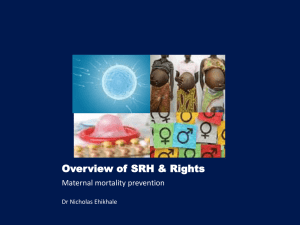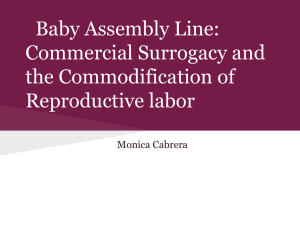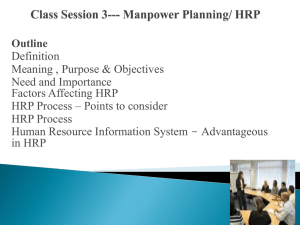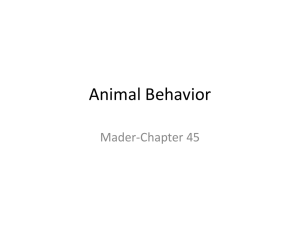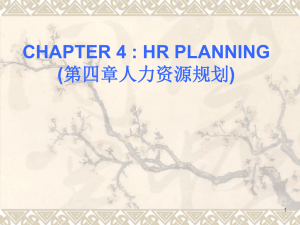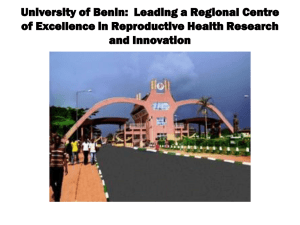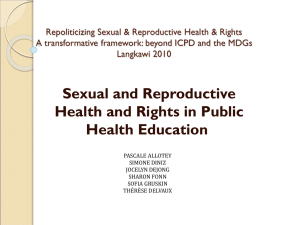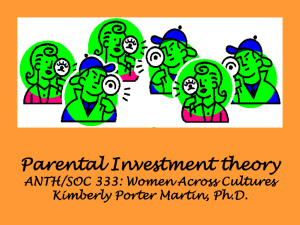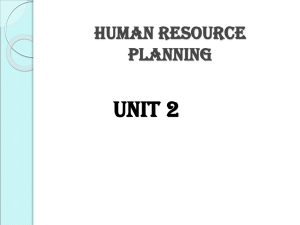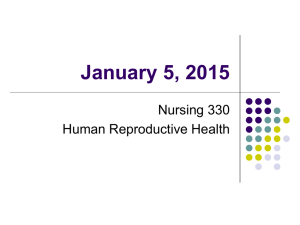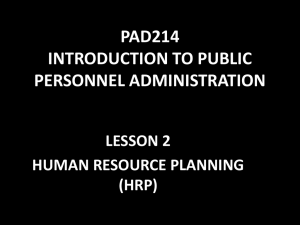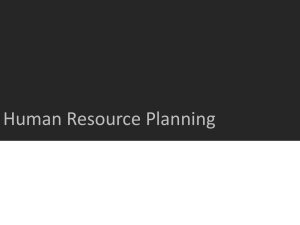HQ/FWC Family, Women`s and Children`s Health
advertisement
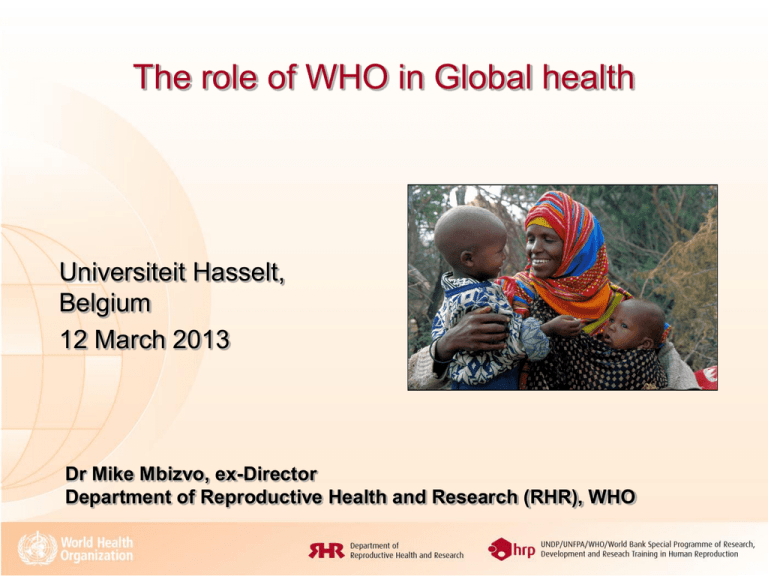
The role of WHO in Global health Universiteit Hasselt, Belgium 12 March 2013 Dr Mike Mbizvo, ex-Director Department of Reproductive Health and Research (RHR), WHO WHO Governance and Structure 2 WHO's definition of health “Health is a state of complete physical, mental and social well-being and not merely the absence of disease or infirmity.” Source: WHO’s Constitution WHO’s mission is global and permanent “The mission of WHO is the attainment by all peoples of the highest possible level of health” Source: WHO’s Constitution The Core Functions of WHO providing leadership on matters critical to health and engaging in partnerships where joint action is needed shaping the research agenda, and stimulating the generation, dissemination and application of valuable knowledge setting norms and standards, and promoting and monitoring their implementation articulating ethical and evidence-based policy options providing technical support, catalysing change and building sustainable institutional capacity monitoring the health situation and assessing health trends. The World Health Assembly is WHO's supreme decision-making body World Health Assembly (WHA) appoints the Director-General upon the recommendation of the Executive Board Reviews and approves the proposed Programme Budget Considers reports of the Executive Board (EB) on technical and health matters, in addition to programme budgetary matters Comprises delegates from all 193 Member States. Many Ministers of Health attend. ONE WHO - three levels of action Headquarters – Global Service Centre – Director General = "DG" Regional Offices – Regional Director = "RD" Country Offices – WHO Country Representatives = "WR" WHO's Global Presence Last but not least, WHO is people. Over 7000 public health experts including doctors, epidemiologists, scientists, managers, administrators and other professionals from all over the world work for WHO in 150 country offices, six regional offices and at the headquarters in Geneva, Switzerland. •♦ •♦Global Service Centre Hierarchy levels Headquarters Office (HQ) – Cluster – Department – Team (some exceptions in GMG) Regional Offices (RO) – Division – Team Country Offices WHO's Regional Offices (RO) Regional Committee governs the work of each region "RD" Regional Director WHO is present in many countries 150 Country offices “WR” = WHO Representative is responsible for WHO’s activities in the countries by supporting the government in the planning and management of national health programmes HWCO = Heads of WHO Country Offices Seven "Clusters" in HQ HQ Headquarters HQ/ODG Office of the Director-General HQ/ General Management Cluster HQ/FWC Family, Women's and Children's Health HQ/HIS Health Systems and Innovation HQ/HSE Health Security and Environment HQ/HTM HIV/AIDS, TB Malaria and Neglected Tropical Diseases HQ/IER Information, Evidence and Research HQ/NMH Noncommunicable Diseases and Mental Health HQ/PEC Polio, Emergencies and Country Collaboration HQ/FWC Family, Women's and Children's Health HQ/FWC Family, Women's and Children's Health PMNCH HQ/ALC Ageing and Life Course HQ/MCA Maternal, newborn, child and adolescent health HQ/IVB Immunization, Vaccines and Biologicals IVR HQ/RHR Reproductive Health and Research HRP How it began … World Health Assembly “REQUESTS the Director-General to develop further the programme proposed: (a) in the fields of reference services, studies on medical aspects of sterility and fertility control methods and health aspects of population dynamics; …” (WHA Resolution 18.49; 1965) 14 How it has evolved 1965: Human Reproduction Unit within existing Division of Family Health (WHA Resolution 18.49; 1965) 1972-1988: WHO (Expanded) Special Programme of Research, Development and Research Training in Human Reproduction 1988-2012: UNDP/UNFPA/WHO/World Bank cosponsored Special Programme (WHA Resolution 41.9; 1988) 2012-present UNDP/UNFPA/UNICEF/WHO/World Bank cosponsored Special Programme UNAIDS becomes PCC permanent member 15 HRP’s governance PCC 15-18 members Standing Committee Scientific and Technical Advisory Group STAG ex-officio members (GAP, RAPs, RP2 and PCC Chairs) Temporary advisers 16 STAG mandate Review, from a scientific and technical standpoint, the content, scope and dimensions of the Special Programme, including the research areas covered and approaches to be adopted Recommend priorities within the Special Programme, including the establishment and disestablishment of task forces, and all scientific and technical activities related to the Special Programme cont'd… 17 …cont'd STAG mandate Provide PCC and the Standing Committee with a continuous and independent evaluation of the scientific and technical aspects of all activities of the Special Programme Review the plans of action and the budget for financial periods prepared by the Executing Agency and make proposals to the Standing Committee for possible reallocation of resources within the scientific and technical component of the Special Programme during each financial period 18 HRP’s scientific and technical advisory bodies STAG Scientific and Ethical Review Group (SERG) + Specialist Panels 18+ experts Research Proposal Review Panel (RP2) Gender and Rights Advisory Panel (GAP) Toxicology Panel Regional Advisory Panels: - African and Eastern Mediterranean Regions Americas Eastern Europe and Central Asian Republics Asia and Western Pacific 19 Scope of STAG mandate and membership In 1999, PCC endorsed the recommendation of STAG to expand its mandate to review the activities of RHR as a whole, rather than just HRP (provided no financial implications to HRP) Membership: Temporary advisor status 3 years if approved by SC and PCC 3 final years if approved by SC and PCC Regional, expertise and gender balance 20 "Because of the good credibility of the Programme and WHO in general, HRP's research results have a greater influence on reproductive health policies and standards than the research of any other organization." (External Evaluation of HRP, Final Report, 2008) 21 Department of Reproductive Health and Research (RHR) Created in November 1998 Composed of two pre-existing entities UNDP/UNFPA/WHO/World Bank Special Programme of Research, Development and Research Training in Human Reproduction (HRP) WHO Division of Reproductive Health (Technical Support) (RHT) RHR = HRP+RHT (PDRH) 22 Mission of HRP To help people lead healthy sexual and reproductive lives Vision statement The attainment by all peoples of the highest possible level of sexual and reproductive health 23 The WHO global reproductive health strategy adopted by WHO's 192 Member States in May 2004 (Resolution WHA 57.12) 24 Opportunity UN Secretary General's Global Strategy for Women's and Children's Health Role of UN agencies Components Define norms, regulations and guidance to Country-led health plans underpin efforts Comprehensive, Help countries align their national practices integrated package of essential interventions and Work together and with others to strengthen services technical assistance to scale-up Integrated care Encourage links between sectors and integration with other international efforts Health systems strengthening Support systems that track progress and identify funding gaps Health workforce capacity building Generate and synthesize research-derived evidence and provide a platform for sharing Coordinated research and best practices, evidence on cost-effective innovation interventions and research findings RHR/HRP core functions Identifying gaps and priorities and shaping the global SRH research agenda Providing leadership on matters critical to improving SRH through knowledge generation, synthesis and management Supporting national research, research and technical capacity strengthening and engaging in relevant partnerships Development of clinical standards, norms and related policy and technical guidance documents Articulating ethical and evidence-based options for policy formulation and programme development to improve SRH, in collaboration with regional and country offices Monitoring and evaluation of SRH situations and trends, advocacy, catalysing change and supporting intervention delivery HRP Objectives Generating new knowledge in SRH Synthesizing research evidence Strengthening research capacity Developing evidence-based guidelines Strengthening research policy dialogue RHR/HRP functions within thematic areas of the WHO Global Reproductive Health Strategy Improving quality of and access to Family planning Document needs and preferences of users and potential users Develop new and improved methods Assess safety and efficacy of existing methods Develop, keep up-to-date and promote evidence-based practice guides for family planning including infertility 29 Improving maternal and perinatal health Improve knowledge on magnitude/burden of leading causes of mortality and morbidity Identify, develop, adapt and evaluate best practices in maternal and perinatal health Conduct research to improve quality of maternal and newborn care and promote utilization of findings Develop, keep up-to-date and promote evidence-based clinical practice guides for maternal and perinatal health 30 Eliminating unsafe abortion and improving postabortion care Generate and synthesize scientifically sound evidence on the prevalence of, and mortality related to, unsafe abortion to assist programmes/policies Support research to identify interventions for the prevention of unsafe abortion and for postabortion care Undertake research to improve methods of safe abortion and promote quality of care Develop, keep up-to-date and promote guidelines for provision of safe abortion, management of abortion complications and provision of postabortion care 31 Combating STIs / RTIs Establish and disseminate evidence for new and improved STI and RTI prevention and control strategies Facilitate microbicide testing, registration (and introduction) Conduct research on prevention of MTCT of HIV and other STIs, on cervical cancer screening and on introduction of HPV vaccines Develop, keep up-to-date and promote implementation of guidelines and tools for STI and RTI policy, programmes, care and surveillance Ensure linkages with HIV prevention (e.g. STI control, male circumcision, prevention of MTCT of HIV and syphilis) 32 Promoting adolescent sexual and reproductive health Support research on factors that affect sexual and reproductive health outcomes, including operations research on the optimal provision of information and services to adolescents Strengthen research capacity and attention to implementation of findings Ensure that technical and managerial tools and advocacy materials produced by the Department also address the unique sexual and reproductive health needs of adolescents (“mainstreaming”) 33 Addressing gender issues and reproductive rights Assess laws, policies, practices rights-based approach to maternal and newborn health assist countries to improve the legal, policy and regulatory environment for sexual and reproductive health Coordinate multinational research aimed at abandonment of female genital mutilation and vaginal practices Continue analyses of data from multicountry study on violence against women Mainstream gender and reproductive rights issues in the Department’s work Develop guidance for health sector on response to violence against women Contribute to understanding of relationship between human rights and sexuality and sexual health 34 Research capacity strengthening Strengthen the research capacity of investigators and infrastructure in developing countries Support researchers to conduct studies based on national priorities in SRH and facilitating their participation in regional and global research Promote dissemination and utilization of research results and evidence-based guidelines in SRH programmes and services Develop strategies to plan, implement, monitor and evaluate programmes to advance SRH 35 Strengthening national research and technical capacity: an ongoing HRP commitment Long-term Institutional Development Development grant grant (LID) Resource Maintenance and Capital grant Service Guidance Centre grant Research Training Grant grant (RTG) RCS RCS Re-entry grant Competitive Intra-regional Research grant Small Supplies grant Courses, Workshops, Seminars grant 36 Thank you "Societies and the political leaders who govern them must first decide that the health of women matters. Public health can do something of course. We can promote better access to sexual and reproductive health services … we can map out technical strategies for reducing maternal deaths" Margaret Chan, Director-General, WHO http://www.who.int/reproductivehealth/en/ 37
